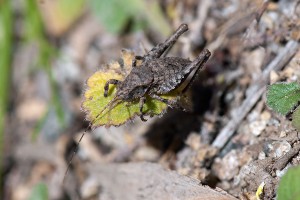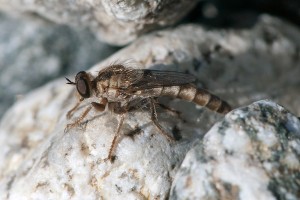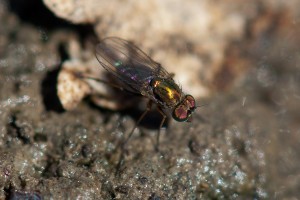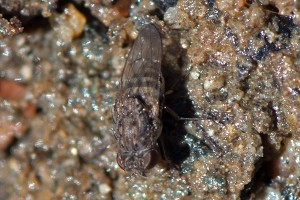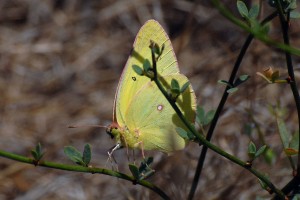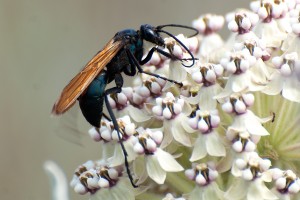Since our last update we’ve added fifteen new taxa to the BFS invertebrate list, including 1 katydid, 2 bugs, 2 beetles, 3 flies, 1 butterfly, 5 bees, and 1 wasp.
As always, many thanks to everyone who’s helped observe, photograph, collect, and identify these inverts, including Ben Stapp, Jonathan Wright, Hartmut Wisch, John Ascher, David Furguson, Eric Fisher, Keng-Lou James Hung, Richard Westcott, Vasily Belov, WonGun Kim, John Carr, and the many other folks at BugGuide.
Here are the newcomers for your perusal:
Katydids:
- Aglaothorax sp. (Orthoptera: Tettigoniidae) – Ovate Shieldback
The Katydid Family (Tettigoniidae) is a new addition to our list, and we have volunteer Ben Stapp to thank for spotting this shield-backed katydid nymph during one of the BFS Volunteer Days. The genus Aglaothorax is restricted to the southwestern US – Nevada, southern California, and western Arizona.
Bugs:
- Lopidea marginata (Hemiptera: Miridae) – Scarlet Plant Bug
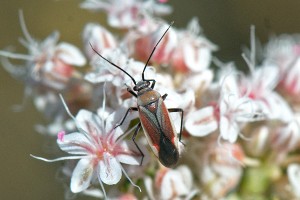
A Scarlet Plant Bug (Lopidea marginata) on California Buckwheat (Eriogonum fasciculatum var. foliolosum). ©Nancy Hamlett.
This pretty little plant bug is strictly a Western species, ranging from Baja California to Washington. Although we spotted it on buckwheat, its host plant is Deerweed (Acmispon glaber). - Oncopeltus fasciatus (Hemiptera: Lygaeidae) – Large Milkweed Bug
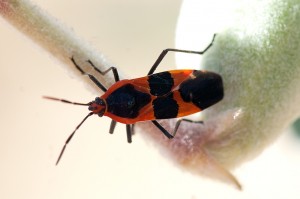
A Large Milkweed Bug (Oncopeltus fasciatus) on Indian Milkweed (Asclepias eriocarpa). ©Nancy Hamlett.
Although we’ve frequently spotted the Small Milkweed Bug (Lygaeus kalmii) at the BFS, this is the first report of the Large Milkweed Bug. The Large Milkweed Bug occurs mainly east of the Rockies, but it also found in the southwestern US. These bugs cannot survive very cold winter temperatures, and northern populations migrate south in the fall to overwinter in southern states. They feed on milkweed plants, preferentially eating the flower buds and seeds, which are rich in nutrients. In the course of feeding these bugs accumulate toxins from the milkweed, which can potentially sicken any predators foolish enough to ignore the bright colors which warn of their toxicity.Oncopeltus fasciatus is easily reared in captivity is considered an “emerging model organism” for research in evolutionary developmental biology (evo-devo), as well as in neurophysiology and studies of ecological interactions among plants, plant pathogens, and insecticides.
Beetles:
- Tanaops sp. (Coleoptera: Melyridae) – a soft-winged flower beetle
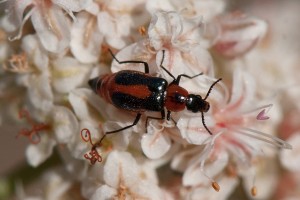
A soft-winged flower beetle (Tanaops sp.) on California Buckwheat (Eriogonum fasciculatum var. foliolosum). ©Nancy Hamlett.
Adult soft-winged flower beetles in the genus Tanaops are often associated with Eriogonum spp., where they feed on nectar and pollen. Tanaops species are found in Western North America, from British Columbia to Sonora, Mexico. There are 12 known species endemic to California, but at least some southern California species have yet to be described. - Chrysobothris subcylindrica (Coleoptera: Buprestidae) – a metallic wood-boring beetle
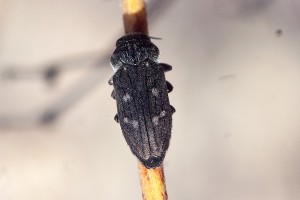
A metallic wood-boring beetle, Chrysobothris subcylindrica, on on California Buckwheat (Eriogonum fasciculatum var. foliolosum). ©Nancy Hamlett.
This beetle is another western species, being found from Oregon and Idaho to California, Arizona, and New Mexico. Some metallic wood-boring beetles are important pests, but this species, which feeds only on plants in the Asteracease family, has not been reported as a problem. (The occurrence of this species on wild buckwheat is incidental.)Our images of C. subcylindrica from the BFS are the first reported to BugGuide of a live specimen in the wild.
Flies:
- Stenopogon lomae (Diptera: Asilidae) – a robber fly
Eric Fisher, who identified this species, says, “Stenopogon lomae belongs to the albibasis group of Stenopogon, which are all small-sized species, usually around 10 mm in length. S. lomae is endemic to the Los Angeles Basin, and Claremont is where some of the original paratype specimens were collected. While many other Stenopogon prefer shrubs, these little Stenopogon (albibasis group – about 9 species) perch on the ground.”Our images from the BFS of are the first (and only) ones this species reported to BugGuide.
- Subfamily Diaphorinae (Diptera: Dolichopodidae) – long-legged flies
Dolichopodidae (Longlegged Flies) are a new family for the BFS invert list. These tiny flies (usually less than 5 mm). They usually have metallic bodies, clear wings, and long legs. Adults of this widespread family prey on small insects. They are also noted for their elaborate courtship, in which the males display their legs to the females. At the BFS, long-legged flies in Subfamily Diaphorinae were spotted on the mud at the pHake Lake boat landing area. - Family Ephydridae (Diptera: Ephydridae) – shore flies
Ephydridae (Shore Flies) are also a new family for the BFS invert list. As the name implies, these small flies are found on shores, including the seashore, shores of lakes and ponds, and even hot springs and geysers. These flies, which are found throughout the US and southern Canada, eat algae and aquatic plants and serve as an important food item for waterfowl. At the BFS, these flies were spotted on the mud at the pHake Lake boat landing area together with mud daubers and longlegged flies.
Butterflies:
- Colias harfordii (Lepidoptera: Pieridae) – Harford’s Sulphur
Harford’s Sulphur is strictly a southern California species and can be found from the coast ranges to northern Baja. Its reported host plants is Astragalus douglasii, which does not occur at the BFS. There is, however, one record of oviposition on another legume, Deerweed (Acmispon glaber), which is where this one was spotted.
Bees:
- Ceratina (Subgenus Zadontomerus) (Hymenoptera: Apidae) – a small carpenter bee
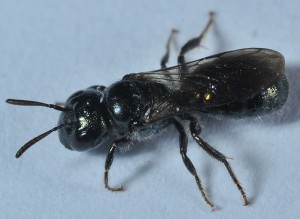
A small carpenter bee, Ceratina (Subgenus Zadontomerus) collected from Phacelia distans along the BFS entry drive. ©Hartmut Wisch.
Small Carpenter Bees, Ceratina, are, as the name suggests, small. In contrast to Large Carpenter Bees (Xylocopa), which are 20 mm or larger, Ceratina are less than 8 mm in length. They excavate nests with their mandibles in the pith of broken or burned plant twigs and stems. Females overwinter as adults in partially or completely excavated stems. In the spring, this resting place (hibernaculum) is modified into a brood nest by further excavation. We had previously observed Ceratina arizonensis, but not any Ceratina in subgenus Zadontomerus. This subgenus is widespread in North America and can be found from Canada to Panama. - Ashmeadiella sp.(Hymenoptera: Megachilidae) – a leaf-cutter bee
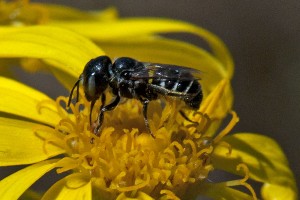
A leaf-cutting bee, Ashmeadiella sp., on Douglas’s Threadleaf Ragwort (Senecio flaccidus var. douglasii). ©Nancy Hamlett.
Ashmeadiella is a common Megachilid that ranges throughout North American south to Costa Rica, with 57 species known in the US and Canada. This year at the BFS they were abundant on Douglas’s Threadleaf Ragwort (Senecio flaccidus var. douglasii) - Anthophora squammulosa (Hymenoptera: Apidae) – an anthophorine bee
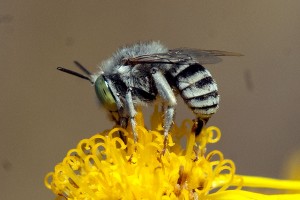
Anthophora squammulosa on Douglas’s Threadleaf Ragwort (Senecio flaccidus var. douglasii). ©Nancy Hamlett.
Anthophora squammulosa occurs throughout the southwestern US and Mexico and is a common species in sage scrub in southern California. Theses zippy flyers tend just to look like fuzzy gray blurs when in the air, but we were able to get photos when they landed on Douglas’s Threadleaf Ragwort (Senecio flaccidus var. douglasii), where they were abundant this year. - Agapostemon texanus (Hymenoptera: Halictidae) – a green metallic bee
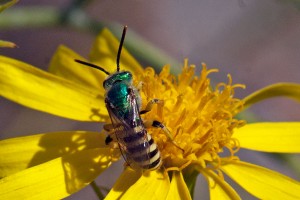
A male green metallic bee, Agapostemon texanus, on Douglas’s Threadleaf Ragwort (Senecio flaccidus var. douglasii). ©Nancy Hamlett.
Another zippy flyer abundant this year on Douglas’s Threadleaf Ragwort (Senecio flaccidus var. douglasii), Agapostemon texanus is widespread in North America, ranging from British Columbia and Washington to Maine, south to Mexico and Georgia. A. texanus is a floral generalist and has been observed on many different types of flowers. The striped abdomen and yellow legs identify the bee in the photo as a male; females have green a abdomen and greenish or blackish legs. - Colletes slevini (Hymenoptera: Colletidae) – Slevin’s Cellophane Bee
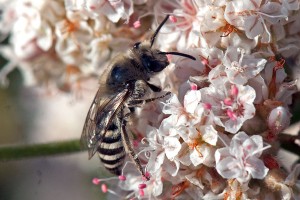
Slevin’s Cellophane Bee, Colletes slevini, on California Buckwheat (Eriogonum fasciculatum var. foliolosum). ©Nancy Hamlett.
Cellophane Bees (genus Colletes) are so-called for the cellophane-like lining – formed by secretions they apply with their mouthparts – that smooths the walls of their nest cells. Although Colletes occur worldwide, Colletes slevini is only found west of the Rocky Mountains, from British Columbia to Baja.
Wasps:
- Pepsis sp. (Hymenoptera: Pompilidae) – Tarantula Hawk
If Tarantulas come, can Tarantula Hawks be far behind? The females of these large, brightly colored, wasps capture, sting, and paralyze tarantulas, which they then either drag back into their own burrows or transport to a specially prepared nest, where the wasp lays a single egg on the spider’s abdomen and covers the nest entrance, as shown in these two YouTube videos (which I think were made in Arizona):
When the wasp larva hatches, it creates a small hole in the spider’s abdomen, then enters the spider’s abdomen and feeds voraciously, avoiding vital organs for as long as possible to keep the spider alive. After several weeks, the larva pupates. Finally, the wasp becomes an adult, and emerges from the spider’s abdomen. The wasp emerges from the nest to continue the life cycle. Tarantula wasps are also nectarivorous, and the one photographed at the BFS appears to be taking nectar from Indian Milkweed (Asclepias eriocarpa).
